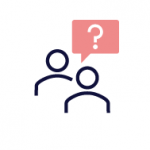What is the Purpose of Assessment?
Assessment is a vital part of the teaching and learning process, yet we seldom pause to consider why we assess our learners. Think about your attitudes towards assessment and feedback: what do you hope to achieve through your current practices? What do you think your learners hope to gain?
Reflection
When we assess learners, we gather evidence of their progress towards meeting learning outcomes and the intended learning goals. We use this information to provide them with timely, actionable feedback on their performance, as well as to adjust and improve our teaching practices. Assessment is more than assigning grades – along with meaningful feedback, it is an integral part of the learning experience designed to promote success.
How do you currently assess your online learners?
This list represents the most common summative and formative assessment methods reported by students in a recent survey of online learning conducted by the University of Ottawa (University of Ottawa, 2021). Many of these methods, such as timed tests, exams, quizzes, and written essays or assignments, fall under the umbrella of “traditional” assessment methods.
Formative and Summative Assessments
Formative Assessments: Ungraded or low-stakes evaluations of learning while students are developing their knowledge and skills. Formative assessments inform instructors about the effectiveness of their teaching, and provide ongoing feedback to students about what they know and have yet to learn.
Examples include polls, Q & As, self-reflections, and concept maps.
Summative Assessments: High-stakes, graded evaluations of performance at the end of a learning unit. Summative assessments determine how well students have met learning outcomes as measured against a set of performance standards.
Examples include mid-term tests, essays, presentations, and final exams.
Traditional Assessment Methods
Most of us are familiar with traditional assessments, such as formal tests, exams, and written assignments. It is quite possible that these are the same assessment methods we experienced as students during our own education. We may currently rely on traditional assessments to evaluate our learners’ progress in our online courses. Let us examine some of the characteristics of these common assessment practices.
Traditional Assessments
Traditional assessments measure a learner’s cognitive ability to recall, recognize, or reconstruct a previously taught body of knowledge. Traditional formal tests generally measure:
- recall of facts,
- articulation of knowledge, and
- comprehension of ideas.

Traditional assessments such as formal tests check learners’ ability to retrieve the content and concepts they studied in a course. They are often used as summative assessment tools to check learning at the end of a unit or upon course completion. Questions typically have only one correct answer and require learners to supply this correct response from memory or select it from a list of choices. In general, learners write standardized, timed, traditional assessments simultaneously and under similar testing conditions.
Traditional assessments ask learners to complete a test or assignment on a particular day and at a specific time. This approach provides a snapshot of what learners know at a given moment during their course or program. Traditional test design and validity rely on learners not knowing the content of the test in advance. Each assessment is often a self-contained item with little connection to previous evaluations within the course.
Feedback on traditional assessments may be limited to test scores or brief after-the-fact comments. It is not surprising, then, that the grades attached to traditional assessments become important. Thus, another defining characteristic of traditional assessments is the focus on the assessment outcome rather than the learning process.
Strengths of traditional assessments
Traditional assessments are more than formal tests and exams. Quizzes, essays, short answer assignments, papers, and problem sets play a role in both formative and summative assessment and feedback strategies.
The primary objectives of traditional assessments are:
- to evaluate how well learners have grasped course content,
- to determine whether the learners have successfully acquired knowledge,
- to assign a grade, and
- to rank and compare learners against standards or their peers.
A main strength of traditional assessments is the ease of both design and grading. Instructors can choose questions for tests and assignments from exam banks, making assessment creation fast and convenient. Answers and solutions are included and save time with marking. Online tests can be easily set up in a Learning Management System (LMS) and often graded automatically.
Traditional assessments drive course curriculum based on “teach and test” cycles, in which learners study content, and then write a test or assignment based on that content. Instructors may find this style of teaching and learning less time consuming and easier to prepare for and deliver.
In addition, traditional assessments are regarded as having high validity and reliability. All learners are administered assessment content in the same way, creating fewer assessment inaccuracies and more consistency. Professional bodies or accreditation organizations often require learners to pass standardized, certified examinations.
Limitations of traditional assessments
Despite the familiarity, consistency, and convenience of these assessment methods, traditional tests, exams, and assignments suffer from a number of limitations.
In the interactive element below, use the menu bar (☰) on the left or the arrows on the right to view the content on all 5 pages.
Online Assessment Challenges
In addition to the pedagogical challenges associated with traditional assessment methods, online assessment and feedback presents practical challenges for both instructors and learners.
Reflection

Concerns over academic integrity rank highly among instructors’ perceived online assessment challenges especially with respect to online tests and exams (University of Ottawa, 2021). Technological strategies to mitigate cheating on online tests, such as remote proctoring, carry their own set of challenges for instructors, including learning new technology and navigating accessibility requests and privacy issues. Other common challenges include difficulty grading online, making observational assessments, and an increase in workload. In addition, delivering online feedback can be cumbersome and time-consuming, and relies on technology-based solutions.

Like instructors, learners also face online testing challenges. Some learners have limited access to the technology needed for remote proctoring due to affordability or internet connectivity speeds, while others may rely on a single, shared computer that may not be available at the time of the test. They may have difficulty finding a suitable space within their homes to take the test without interruption. Learners in the global classroom face additional challenges such as time zone differences and blocked internet access to certain sites in their host countries.
The online learning environment may also magnify some learners’ poor time management skills, affecting their ability to complete assignments on time. In addition, it can be more challenging for team members to connect to work on group assignments. Online learners can feel isolated and disconnected from instructor feedback, especially in an asynchronous setting.
Are Traditional Strategies Enough?
The continually shifting nature of Ontario’s post-secondary education ecosystem adds complexity to delivering valid, relevant and fair online assessments. No longer simply a matter of “diplomas and degrees”, Ontario institutions now offer a wide range of credentials through a variety of delivery modes to diverse groups of learners.
Ontario’s evolving post-secondary landscape
Click on the “+” icons to reveal more information.
Taken together, these pedagogical, practical, and contextual considerations require us to reflect on whether we can achieve meaningful measures of learner success in online courses, using only traditional assessment methods.

Alternatively, should we be aiming towards a more balanced assessment strategy that incorporates alternative methods for our formative and summative assessments?

